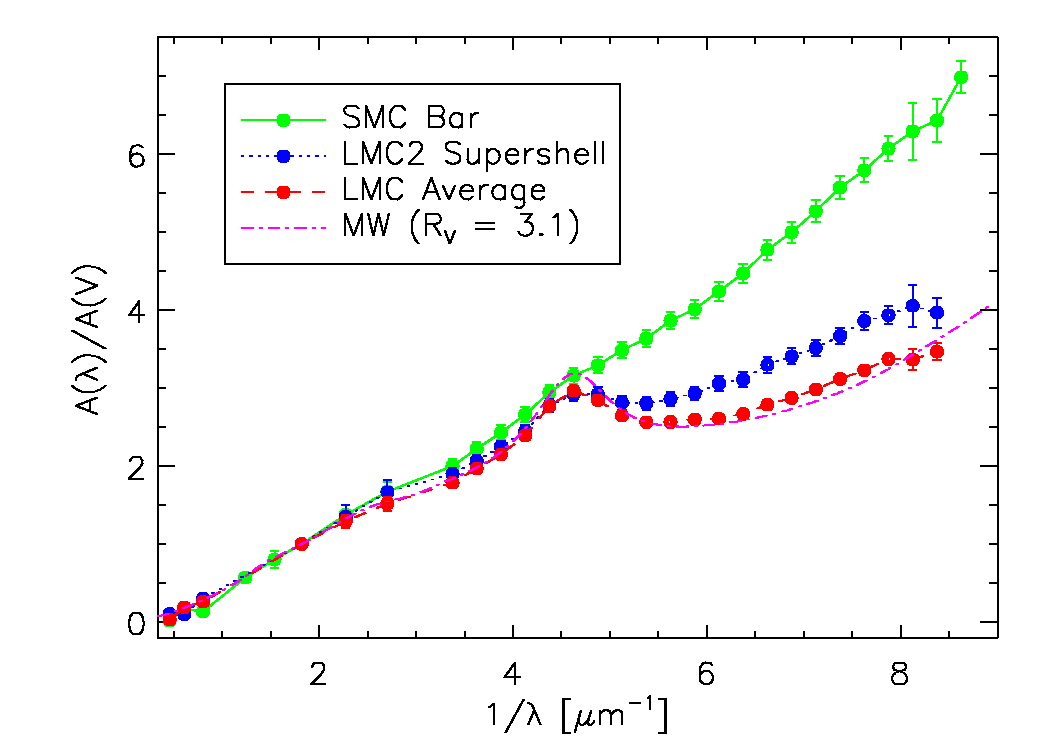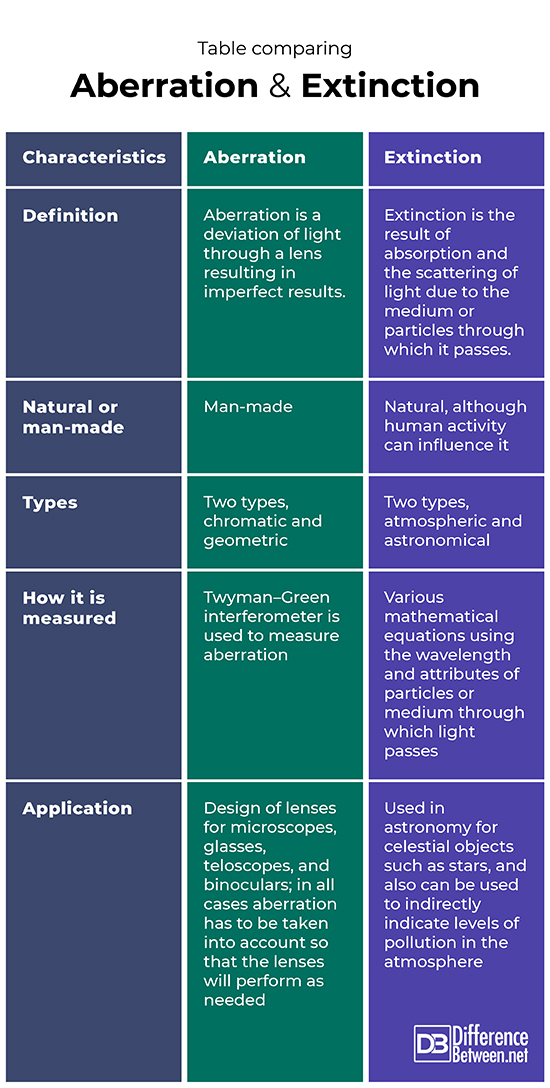Difference Between Aberration and Extinction
Aberration is a deviation of light through a lens resulting in imperfect results. Extinction is the result of absorption and the scattering of light due to the medium or particles through which it passes.

What is Aberration?
Definition:
Aberration is a term commonly used in physics to describe the situation where an optical system does not give the results that is wanted because light deviates in some way as it passes through a lens.
Types of aberration:
There are different types of aberration that occur which need to be addressed when designing optical systems. Geometric aberrations are related to the curved shape of a mirror or a lens. A type of geometric aberration is spherical aberration which occurs because of differences in the focal length of a spherical lens at different distances. Chromatic aberration involves a problem with colors; essentially the lens does not focus all the colors to the same location resulting in unwanted effects.
How it is measured:
An instrument called a Twyman–Green interferometer is commonly used to measure aberration of optical systems.
Examples:
Examples of geometric aberrations include distortions and astigmatisms that occur, which are related to the shape of the lens. Chromatic aberration can include, for example, axial and transverse aberrations. The axial aberration is a common problem which engineers accommodate for when designing lenses. The transverse chromatic aberration only becomes an issue at short focal lengths.
Application:
Understanding the different types and forms of aberrations is crucial for engineers and designers of optical systems. The systems need to be built taking into account these potential issues, so the design of lenses in microscopes, glasses, teloscopes, and binoculars, all require knowledge of aberrations.

What is Extinction?
Definition:
In physics, the term extinction describes the total sum of the absorption and dispersion of light by particles or gas in the air. Extinction can be confused with aberration in that both terms are related to light and the movement of light.
Types of extinction:
Extinction can be calculated for the earth’s atmosphere but also for astronomical objects. There are different extinction coefficients based on the size and nature of the particles or medium through with light rays pass.
How it is measured:
Since the extinction of light waves is due to the particles or medium the light moves through or strikes, it makes sense that measuring extinction has a lot to do with measures related to the actual particles. Besides parameters of the particles, the actual wavelength of light is also relevant to a determination of extinction.
Examples:
The changes in the color of the sky when the sun rises and sets are examples of extinction, since the sun is at a lower position in the sky relative to the horizon and light rays pass through more molecules of air; this explains why color of the sky is orange at sunrise and sunset. This means that the absorption and scattering of the light is different than when the sun is higher in the sky.
Application:
Extinction coefficients are commonly measured for astronomical objects and can be used along with other measurements to indicate attributes of celestial objects such as stars. When measured in the atmosphere, these same coefficients can indirectly indicate how much pollution is present in the air. This was a method suggested in the past for measuring air pollution.
Difference between Aberration and Extinction?
Definition
Aberration is a type of deviation of light when it passes through a lens resulting in imperfect results. Extinction is the result of absorption and the scattering of light due to the medium or particles through which it passes.
Natural or man-made
Aberration is due to man-made lenses while extinction is a natural phenomenon, although it can be influenced by pollution.
Types
There are two main types of aberration that occur, namely, chromatic and geometric. There are two broad types of extinction that can be measured, namely, atmospheric and astronomical.
How it is measured
Aberration is measured using an instrument called a Twyman–Green interferometer. Extinction is measured using various mathematical equations that take into account both measures of the particles or medium and the wavelength of the light.
Application
Aberration is important to take into account in the design of lenses for microscopes, glasses, teloscopes, and binoculars. Extinction is used for astronomical measures, and was in the past used for estimating pollution levels.
Table comparing Aberration and Extinction

Summary of Aberration Vs. Extinction
- Aberration and extinction are both terms used in physics that are related to the behavior of light rays.
- Aberration always refers to distortions or changes to light rays based on the movement through a lens.
- Extinction is the behavior of light due to the impact of the rays with particles or a medium and is related to the scattering and absorption of light.
- People may confuse extinction and aberration but aberration always involves lenses and extinction is based on scattering and absorption of light rays.
- Difference Between Rumination and Regurgitation - June 13, 2024
- Difference Between Pyelectasis and Hydronephrosis - June 4, 2024
- Difference Between Cellulitis and Erysipelas - June 1, 2024
Search DifferenceBetween.net :
Leave a Response
References :
[0]Malacara, D. "Twyman–Green interferometer." Optical shop testing 2 (1992): 46-96.
[1]Sabetghadam, Samaneh, and Farhang Ahmadi-Givi. "Relationship of extinction coefficient, air pollution, and meteorological parameters in an urban area during 2007 to 2009." Environmental Science and Pollution Research 21.1 (2014): 538-547.
[2]Tatum, Jeremy. "Scattering, extinction, and opacity". California State University, 2019, https://phys.libretexts.org/Bookshelves/Astronomy__Cosmology/Book%3A_Stellar_Atmospheres_(Tatum)/05%3A_Absorption%2C_Scattering%2C_Extinction_and_the_Equation_of_Transfer/5.03%3A_Scattering%2C_Extinction_and_Opacity
[3]Image credit: https://commons.wikimedia.org/wiki/File:Interstellar_extinction_ave_curves_local_group.png
[4]Image credit: https://upload.wikimedia.org/wikipedia/commons/thumb/a/aa/Chromatic_aberration_lens_diagram.svg/500px-Chromatic_aberration_lens_diagram.svg.png
